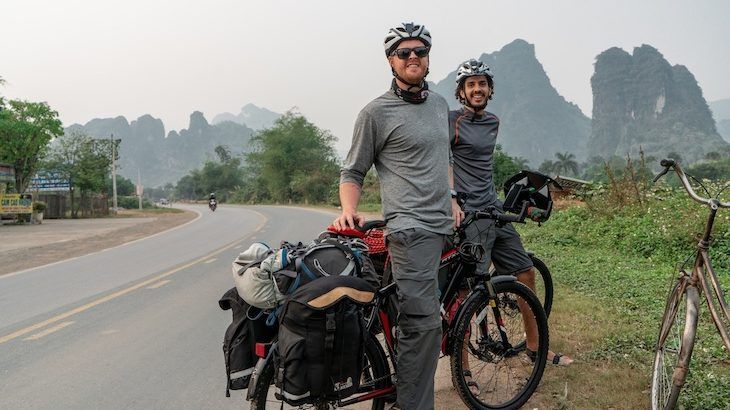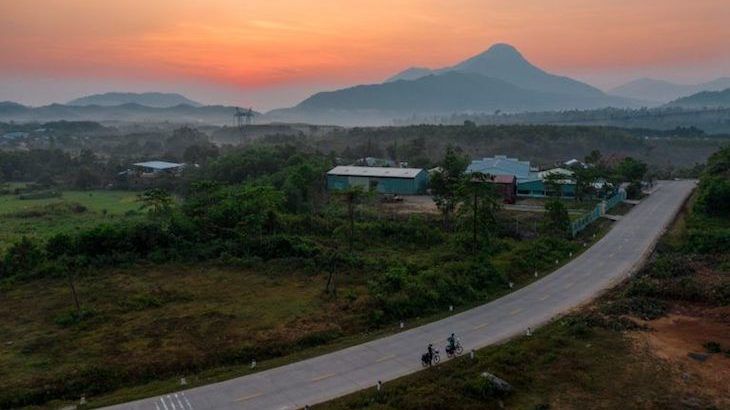10 Tips: Get the Most out of Your Bikepacking Trip
Tips to overcome the daunting idea of covering long distances by bike

By Karam Nwilati
For most people, cycling is a means of transportation or a fun way to get some physical activity in. When it comes to travel, however, cycling can also be an intimate way to cover long distances and explore a place. Bikepacking can seem daunting due to the physical element of it, and the idea of carrying additional weight while riding. I had so many questions when planning a two-month bikepacking trip across Vietnam (Where do I start? What equipment do I need?). Here I’ll share ten of the best pieces of advice I learned from Hanoi to Ho Chi Minh City.
1. Don’t worry (too much) about your fitness.
Don’t let your current level of fitness dissuade you from considering a bikepacking trip. People often balk at the fitness factor; they’re scared about the physical element of it and they don’t think they’re fit enough to bike tour. If you’re not a cyclist, but in decent shape (i.e. have no medical issues preventing you from doing physical activity) then you’ll honestly get most of your fitness on the road. In the first few days listen to your body, keep your mile count low, and ease your muscles and body into the routine. Before I started my trip, the most I’d ever cycled was a flat 19-mile stretch in a city. During the first week of the trip, we didn’t cover very much distance. In fact, on day three we ended up pushing our bikes for ten miles. Learn to be okay with having a slow pace as you give your body and mind time to adjust. There will be plenty of time to increase miles and speed once your body has acclimated and gained a little more fitness.

2. Choose the right bike.
Your bicycle is essentially your home, so choose the right one for you and for the terrain. In retrospect, this is where Chris, my friend who accompanied me on the trip, and I went wrong. Both Chris and I are over six feet tall and ride large-frame bikes back home. When we were buying our touring bikes in Hanoi, we ended up buying medium-frame mountain bikes instead of shelling out twice as much money for the large-frame hybrids. That was the wrong choice. When buying your touring bike, do research beforehand and determine what kind of terrain you’ll be riding on. For example, if it’s paved roads then a road bike is best. Hybrids offer a great in-between solution and have greater efficiency, but mountain bikes simply lose too much efficiency with the front suspension. Having medium-frame bikes gave us a lot of trouble when it came to our weight: the smaller wheels couldn’t handle the weight and we broke a lot of spokes. Even with our bike handicap we still made it work, so try to find the best bike but don’t worry if have to make do with something else.
3. Distribute your weight properly.
Speaking of broken spokes, make sure to distribute your weight properly. The combination of our smaller bikes and a lot of weight on the back wheels caused a lot of spokes to break. This problem could have been avoided entirely if the weight on the bikes was properly distributed. All of our bags and panniers were on the back rack, when we should have actually used the front-wheel panniers to distribute the weight. I’ve written a guide on how to pack your bike that allows you to see our setup. (see link to article below)

4. Take it day by day.
Enjoy the freedom of this kind of experience and try to take it day by day. Chris and I never woke up being 100% sure where we would be sleeping that night. After researching our route, reading a few blog posts, and getting advice from locals, we’d start cycling and evaluate where would be a reasonable place to stop that night. If it was a bigger city that was on the touristy side, we always booked accommodations beforehand. If it was a small town we’d find a hotel or a place to camp close by when we got there.
5. Keep it cheap.
Bikepacking is a great way to travel on a budget, and the less you spend the farther you can go. Once you have a bike and panniers, food will be your main expense (and accommodations if you’re not camping). One of the reasons that Chris and I chose Vietnam was because it’s a relatively cheap country to travel in. You can get a meal for about $1 and a bed in a hotel or hostel for $5. It’s very possible to live comfortably on less than $10 a day, and it will be even cheaper if you camp, cook your own food, and avoid the super touristy locations.

6. Download a good playlist (or two).
Music is such a powerful mood booster and motivator when it comes to physical activity. We had some boring days of cycling alongside a highway with very loud trucks and relentless honking. The best way to handle this noisy slog, for us, was to make a playlist and sync it up. Chris and I had a great time riding side-by-side and singing along to ABBA. Pro tip: make sure that the music isn’t too loud, or that you only use one earbud. You still want to be able to hear sounds from the road so you can ride safely.
7. Communication is key.
If you have a partner, tell them everything. When I say everything, I mean everything. This may sound like relationship advice (and it totally is) but think about spending 24/7 with someone for two months. You’re bound to have some disagreements, and it’s much better to deal with any issues right away. If your travel partner does or says something you don’t agree with, tell them right away and deal with it in the moment. For example, Chris loves smashing a bunch of miles and wants to go as far as possible everyday, whereas I prefer going slower, capturing moments, and sharing the journey as we go. When Chris was rushing, I made sure to tell him (nicely!). When I was taking too long, he made sure to tell me. This intentional communication made the trip enjoyable and we finished the ride closer than ever.

8. Download Google Translate.
If you’re touring somewhere where you don’t speak the language then Google Translate should be your best friend. Did you know that you can download languages for offline translation? Chris and I don’t speak Vietnamese and this feature became incredibly useful when we were in smaller villages in the mountains with no cell service. We were able to have conversations with the locals and our hosts who spoke little-to-no English.
9. Embrace the local cuisine (and people!)
One of my favorite parts about traveling is experiencing the culture of a place through food. Vietnam is famous for its food, and for good reason. I still dream about the ph?, bún ch?, ch? cá, bún bò nam b?, and all the bánh mì I ate. If you’re following a certain diet you may have to be more flexible than you’d like or come extra prepared. Chris and I don’t have any dietary restrictions, but there would be additional challenges for someone who does, especially in the more remote areas of the country where communicating what your dietary needs may be difficult. If you have a food allergy, I would go into the situation a little more prepared (Google Translate!) and do some research about common foods/dishes beforehand.

I loved the way that people seemed to be drawn to us, and eager to help us out, when they saw that we were traveling on bicycles. They could immediately sense the amount of discomfort we’d put ourselves in and seemed to relate to us better because of it. Vietnam is a beautiful place filled with some of the most kind and hospitable people we have ever met, and was a great choice for my first bike tour. Interacting with locals and talking to them was one of the most rewarding parts of the experience.
10. Maintain a positive mindset.
There will be hard moments: your body will be exhausted, the sun will be beating down on you for hours on end, and you’ll encounter numerous unexpected obstacles. In the hardest moments it’s especially important to do your best to stay positive. Only you can control how much your enjoy the trip. If I were to take only one lesson home from this bike tour, it’s that mindset plays the most crucial role in shaping one’s experience. Maybe it’s your mindset as you tackle the uphills or being intentional about shaping your overall mindset just before starting your trip, but if you go into an uphill thinking you can’t do it, then you’ll likely stop halfway up. Having a positive attitude will lead you to have a better time. In difficult moments, try to remember that you’re on a fun trip and enjoying yourself overall––it can make all the difference.

If you have any specific questions about bikepacking, reach out to Karam on Instagram.
Check out our next Expedition: Part One: Sail to Ski British Columbia
